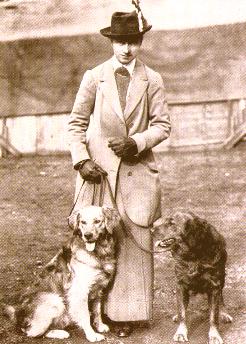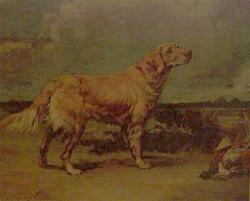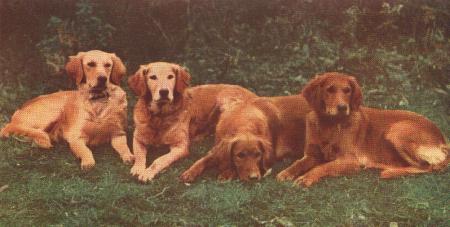History of The Golden Retriever Club

Mrs Charlesworth with Noranby Sandy (left) & Noranby Balfour
To quote Mrs Charlesworth
“In 1910, a small but determined band of enthusiasts laid their heads together to further the interests of the breed which they had worked so hard to bring to the forefront of the battle. having at long last obtained official recognition and separate classification for our favourites at ‘the hands of the
powers that be,’ ie the Kennel Club, we launched on the public a ‘new breed’ (new since 1870 or so) known as ‘Retrievers, Yellow or Golden.’ Not content with these concessions to the yearly increasing numbers of Goldens. We felt the time had come when their interests should be fostered and guarded by means of a Specialist Club. Hence the birth of the Golden Retriever Club in 1911”
In those days they had a small committee of four, and a tiny list of members. They showed their Goldens at every show to which they could afford to travel, guaranteed the classes and won their own prizes. In a comparatively short time, one or two Goldens managed to catch the eye of Field Trial Judges, simply because it became impossible to ignore the sterling work done by them in the field.
So the foundations of the Golden Retriever as a breed were well and truly laid before the First World War, during which breeding was only under Kennel Club Licence. No field Trials were held, although some of the big shows continued until 1917, in which year Golden entries at Cruft’s were only twenty-six as opposed to the grand total of seventy there had been in 1915.
To quote Elma Stonex, who through years of research discovered the true origins of the breed,
“At that time the breed was still big and heavy, with rather long backs and often with tremendous coats. These dogs were criticised as cumbersome and a good deal slower in the field
than the other Retriever breeds, although they had the softest of mouths and were exceptionally good in water. We owe a great debt to those early breeders, whose efforts and work in careful
breeding were crowned with success in producing from them down the years (without the use of outside blood) a balanced short-coupled dog, with a dense and water-resisting but manageable coat, and who although remaining powerful and heavily boned, should yet be active, fast and handy in size. In doing this, these pioneers also succeeded in retaining the broad skull and powerful muzzle, ideal for brains and for practical work, and with them the very kindly and noble expression so characteristic of the original Guisachan dogs – the aim of all breeders today.”

St Huberts Peter, owned by Col Le Poer Trench
He is said to have kept the original strain of ‘Yellow & Russian Retrievers & Trackers’, (as they were called) pure and never crossed them as Lord Tweedmouth did. They were exhibited until 1914.
With the restarting of Field Trials in 1920 and of shows in 1921 the inter-war years saw the beginning of a gradual rise to popularity for Goldens supported by a substantial number of new breeders. In 1921 for the first time KC registrations reached 120. These rose to 375 by 1925 and steadily continued rising until1073 was reached in 1938, the last normal year before the Second World War.
In 1921 the GRC ran its first Trials and these of course were the first to be confined to the breed, although Goldens were already proving that they could well hold their own in any variety stake competition. Cruft’s entries in 1921were only 34, but this rose to 231 in 1925 and to 263 in 1927, which remained the highest figure until after the war.
As early as 1930 a number of dogs of the breed had been exported and were in Canada, the USA, South America, India, Kenya, France, Belgium and Holland.

L to R: Silence of Tone, Noran by Black-Eyed Susan, Ch Noranby Diana, Noranby Jane
When the breed standard had first been drawn up by the GRC in 1911, cream had been excluded as a permissible colour, and in the 1920’s light-coloured dogs were not popular, the favoured colour being sometimes very red and dark indeed. But the lighter colour gained greatly in popularity in the early 30’s and in 1936 the Standard was altered to read ‘Any shade of gold or cream, but neither red or mahogany’ as it was realised that a mistake had been made in not allowing the original colour.
